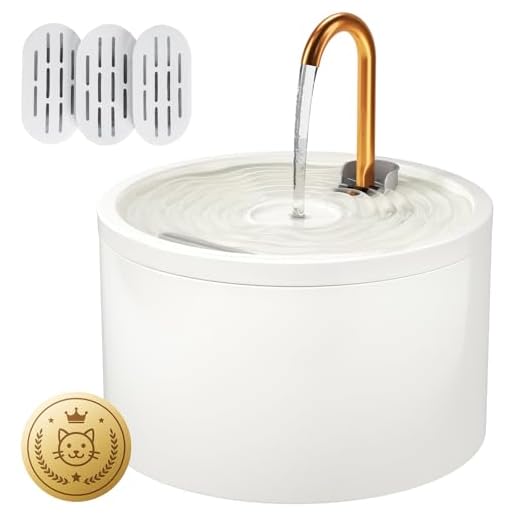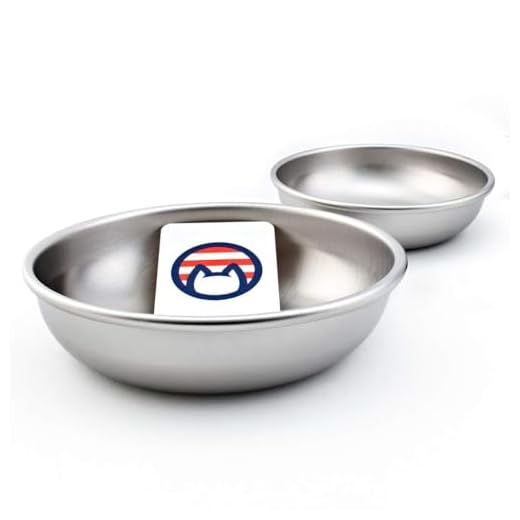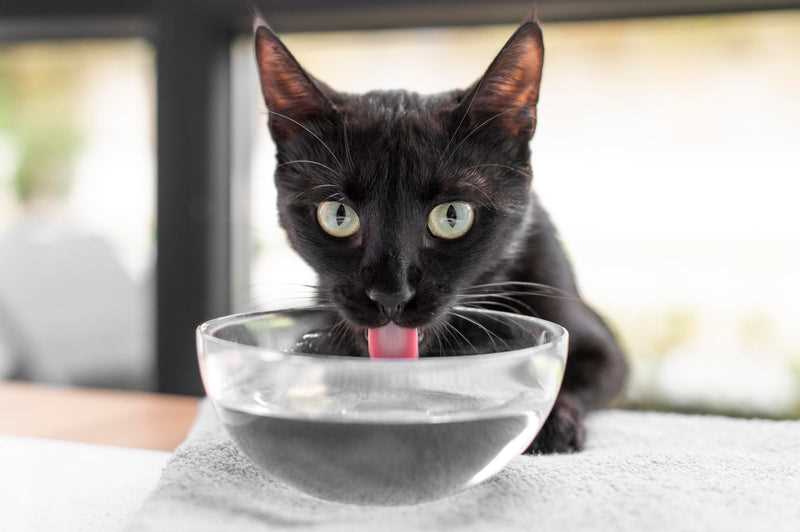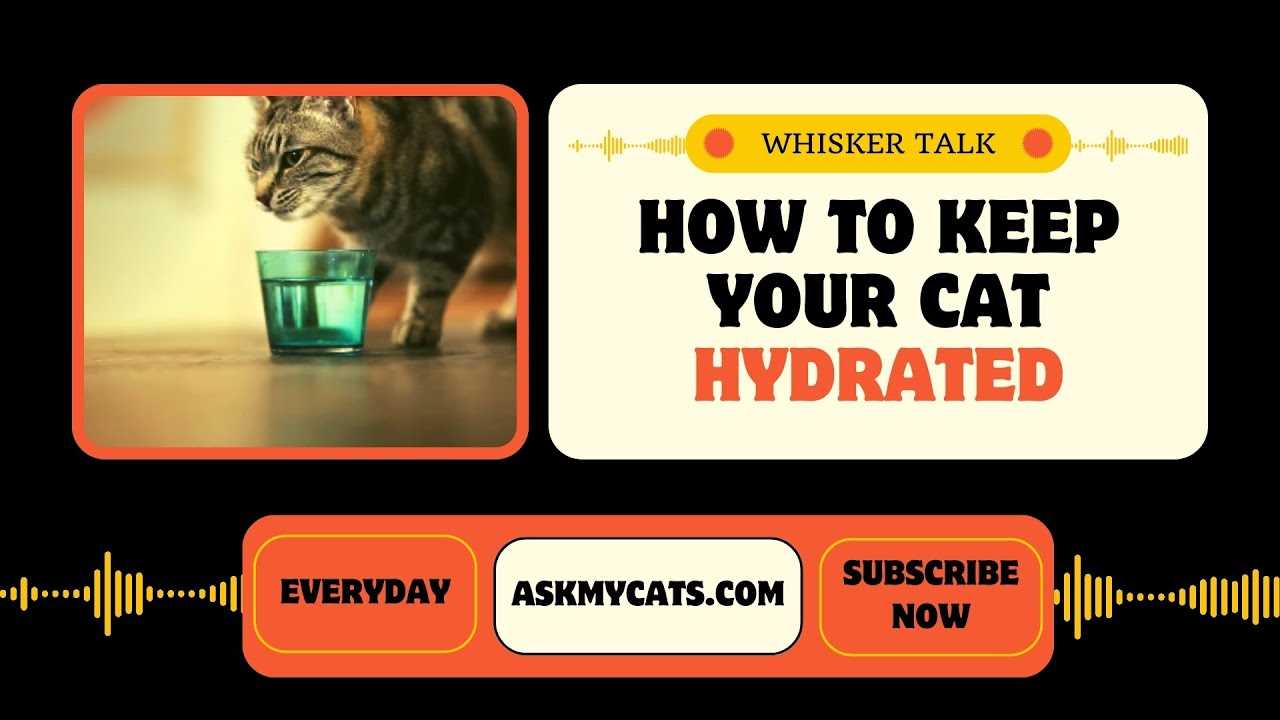



Always offer fresh water in a clean bowl. Cats appreciate a constant supply of cool, filtered water. Change it daily to prevent any unpleasant odors or tastes that might deter drinking.
Consider a pet water fountain. The sound of running water can entice many felines to drink more. The movement keeps the water oxygenated and fresh, making it more appealing.
Incorporate wet food into meals. High-moisture diets can significantly boost fluid intake. Look for high-quality canned options that list meat as the primary ingredient.
Add water to dry kibble. Mixing in a little water can create a tasty gravy that encourages consumption of both food and fluids. Just ensure it remains palatable.
Introduce ice cubes on warm days. Some enjoy playing with ice, and it can be a fun way to cool off while also sipping on melting ice.
Monitor bathroom habits. Regular litter box checks can indicate hydration levels. If urination habits change, it may signal a need for increased fluid intake.
Choosing the Right Water Bowl for Your Feline Friend

Opt for a bowl made of stainless steel or ceramic. These materials are non-porous, making them easier to clean and less likely to retain odors, unlike plastic options that can cause irritation. A shallow design is preferable; it allows easy access without whisker fatigue, which occurs when sensitive whiskers brush against the sides of a deep bowl.
Size Matters

The size of the container should accommodate your furry pal’s drinking habits. A wider bowl can hold more liquid and helps prevent spills. Ensure it’s heavy enough to avoid tipping during enthusiastic drinking sessions.
Placement and Accessibility

Position the bowl in a quiet, low-traffic area. Cats prefer a calm environment for drinking. Ensure it’s easily accessible, especially for older or less mobile companions. A consistent location will help establish a routine, encouraging more frequent drinking.
For more tips related to feeding, check out this link: how long can dry cat food sit out.
Incorporating Wet Food into Your Cat’s Diet
Adding wet food to meals can significantly boost moisture intake. Look for high-quality options that list meat as the first ingredient. Brands vary, so check the nutritional labels for protein content and avoid those with fillers like corn or wheat.
Transition gradually to avoid digestive issues. Start with a mix of dry and wet foods, then increase the wet portion over several days. This helps adjust taste preferences and ensures a smooth dietary change.
Serving wet food at room temperature enhances aroma and palatability. Consider using small, shallow dishes to make it easy to access. Freshness matters; leftover food should be refrigerated and consumed within a day to prevent spoilage.
Experiment with different flavors and textures to find what appeals most. Cats can be finicky, so rotating flavors can keep meals exciting. Remember to consult with a vet if you’re unsure about specific brands or types.
In addition to wet food, consider safe plants like can cats eat dandelions as a supplement to their diet. This can provide hydration and nutritional benefits while keeping mealtimes interesting.
FAQ:
What are some signs that my cat is dehydrated?
Dehydration in cats can manifest through various signs. Look for symptoms such as dry gums, lethargy, loss of appetite, and decreased skin elasticity. You can perform a simple skin test by gently pinching the skin on the back of your cat’s neck; if it doesn’t return to its normal position quickly, it may indicate dehydration. Additionally, observe your cat’s behavior; if it seems less active or is drinking less water than usual, these could be indicators of dehydration.
How can I encourage my cat to drink more water?
Encouraging your cat to drink more water can be achieved through several methods. One effective approach is to provide fresh, clean water in multiple bowls around the house. Cats often prefer running water, so consider investing in a pet water fountain. Additionally, you can incorporate wet cat food into their diet, as it contains moisture that contributes to hydration. Some cats may also enjoy flavored water or ice cubes made from low-sodium broth, which can entice them to drink more.
Is it safe to give my cat flavored water or broth?
Yes, giving your cat flavored water or broth can be safe, provided that the broth is low in sodium and free from onion or garlic, which can be harmful to cats. Always check the ingredients before offering it to your cat. Flavored water can encourage hydration and may be particularly appealing to cats that are reluctant to drink plain water. However, it should not replace their regular water intake, and fresh water should always be available.
How much water should my cat drink daily?
The amount of water a cat needs can vary based on factors like age, diet, and activity level. Generally, a cat should drink about 2.5 to 5 ounces of water per 5 pounds of body weight daily. If your cat primarily eats dry food, it may need more water compared to one that consumes wet food, which has a higher moisture content. Always monitor your cat’s drinking habits and consult with your veterinarian if you have concerns about their hydration levels.
What are some methods to keep my cat’s water clean and appealing?
Keeping your cat’s water clean is vital for encouraging them to drink more. Change the water daily to ensure freshness, and wash the bowls regularly with soap and water to remove any residue. Using stainless steel or ceramic bowls can help, as they are less likely to retain odors compared to plastic. Additionally, consider placing the water bowls in quiet, low-traffic areas, as some cats are sensitive to noise and movement, which can deter them from drinking.
Always offer fresh water in a clean bowl. Cats appreciate a constant supply of cool, filtered water. Change it daily to prevent any unpleasant odors or tastes that might deter drinking.
Consider a pet water fountain. The sound of running water can entice many felines to drink more. The movement keeps the water oxygenated and fresh, making it more appealing.
Incorporate wet food into meals. High-moisture diets can significantly boost fluid intake. Look for high-quality canned options that list meat as the primary ingredient.
Add water to dry kibble. Mixing in a little water can create a tasty gravy that encourages consumption of both food and fluids. Just ensure it remains palatable.
Introduce ice cubes on warm days. Some enjoy playing with ice, and it can be a fun way to cool off while also sipping on melting ice.
Monitor bathroom habits. Regular litter box checks can indicate hydration levels. If urination habits change, it may signal a need for increased fluid intake.
Choosing the Right Water Bowl for Your Feline Friend

Opt for a bowl made of stainless steel or ceramic. These materials are non-porous, making them easier to clean and less likely to retain odors, unlike plastic options that can cause irritation. A shallow design is preferable; it allows easy access without whisker fatigue, which occurs when sensitive whiskers brush against the sides of a deep bowl.
Size Matters

The size of the container should accommodate your furry pal’s drinking habits. A wider bowl can hold more liquid and helps prevent spills. Ensure it’s heavy enough to avoid tipping during enthusiastic drinking sessions.
Placement and Accessibility

Position the bowl in a quiet, low-traffic area. Cats prefer a calm environment for drinking. Ensure it’s easily accessible, especially for older or less mobile companions. A consistent location will help establish a routine, encouraging more frequent drinking.
For more tips related to feeding, check out this link: how long can dry cat food sit out.
Incorporating Wet Food into Your Cat’s Diet
Adding wet food to meals can significantly boost moisture intake. Look for high-quality options that list meat as the first ingredient. Brands vary, so check the nutritional labels for protein content and avoid those with fillers like corn or wheat.
Transition gradually to avoid digestive issues. Start with a mix of dry and wet foods, then increase the wet portion over several days. This helps adjust taste preferences and ensures a smooth dietary change.
Serving wet food at room temperature enhances aroma and palatability. Consider using small, shallow dishes to make it easy to access. Freshness matters; leftover food should be refrigerated and consumed within a day to prevent spoilage.
Experiment with different flavors and textures to find what appeals most. Cats can be finicky, so rotating flavors can keep meals exciting. Remember to consult with a vet if you’re unsure about specific brands or types.
In addition to wet food, consider safe plants like can cats eat dandelions as a supplement to their diet. This can provide hydration and nutritional benefits while keeping mealtimes interesting.
FAQ:
What are some signs that my cat is dehydrated?
Dehydration in cats can manifest through various signs. Look for symptoms such as dry gums, lethargy, loss of appetite, and decreased skin elasticity. You can perform a simple skin test by gently pinching the skin on the back of your cat’s neck; if it doesn’t return to its normal position quickly, it may indicate dehydration. Additionally, observe your cat’s behavior; if it seems less active or is drinking less water than usual, these could be indicators of dehydration.
How can I encourage my cat to drink more water?
Encouraging your cat to drink more water can be achieved through several methods. One effective approach is to provide fresh, clean water in multiple bowls around the house. Cats often prefer running water, so consider investing in a pet water fountain. Additionally, you can incorporate wet cat food into their diet, as it contains moisture that contributes to hydration. Some cats may also enjoy flavored water or ice cubes made from low-sodium broth, which can entice them to drink more.
Is it safe to give my cat flavored water or broth?
Yes, giving your cat flavored water or broth can be safe, provided that the broth is low in sodium and free from onion or garlic, which can be harmful to cats. Always check the ingredients before offering it to your cat. Flavored water can encourage hydration and may be particularly appealing to cats that are reluctant to drink plain water. However, it should not replace their regular water intake, and fresh water should always be available.
How much water should my cat drink daily?
The amount of water a cat needs can vary based on factors like age, diet, and activity level. Generally, a cat should drink about 2.5 to 5 ounces of water per 5 pounds of body weight daily. If your cat primarily eats dry food, it may need more water compared to one that consumes wet food, which has a higher moisture content. Always monitor your cat’s drinking habits and consult with your veterinarian if you have concerns about their hydration levels.
What are some methods to keep my cat’s water clean and appealing?
Keeping your cat’s water clean is vital for encouraging them to drink more. Change the water daily to ensure freshness, and wash the bowls regularly with soap and water to remove any residue. Using stainless steel or ceramic bowls can help, as they are less likely to retain odors compared to plastic. Additionally, consider placing the water bowls in quiet, low-traffic areas, as some cats are sensitive to noise and movement, which can deter them from drinking.
Always offer fresh water in a clean bowl. Cats appreciate a constant supply of cool, filtered water. Change it daily to prevent any unpleasant odors or tastes that might deter drinking.
Consider a pet water fountain. The sound of running water can entice many felines to drink more. The movement keeps the water oxygenated and fresh, making it more appealing.
Incorporate wet food into meals. High-moisture diets can significantly boost fluid intake. Look for high-quality canned options that list meat as the primary ingredient.
Add water to dry kibble. Mixing in a little water can create a tasty gravy that encourages consumption of both food and fluids. Just ensure it remains palatable.
Introduce ice cubes on warm days. Some enjoy playing with ice, and it can be a fun way to cool off while also sipping on melting ice.
Monitor bathroom habits. Regular litter box checks can indicate hydration levels. If urination habits change, it may signal a need for increased fluid intake.
Choosing the Right Water Bowl for Your Feline Friend

Opt for a bowl made of stainless steel or ceramic. These materials are non-porous, making them easier to clean and less likely to retain odors, unlike plastic options that can cause irritation. A shallow design is preferable; it allows easy access without whisker fatigue, which occurs when sensitive whiskers brush against the sides of a deep bowl.
Size Matters

The size of the container should accommodate your furry pal’s drinking habits. A wider bowl can hold more liquid and helps prevent spills. Ensure it’s heavy enough to avoid tipping during enthusiastic drinking sessions.
Placement and Accessibility

Position the bowl in a quiet, low-traffic area. Cats prefer a calm environment for drinking. Ensure it’s easily accessible, especially for older or less mobile companions. A consistent location will help establish a routine, encouraging more frequent drinking.
For more tips related to feeding, check out this link: how long can dry cat food sit out.
Incorporating Wet Food into Your Cat’s Diet
Adding wet food to meals can significantly boost moisture intake. Look for high-quality options that list meat as the first ingredient. Brands vary, so check the nutritional labels for protein content and avoid those with fillers like corn or wheat.
Transition gradually to avoid digestive issues. Start with a mix of dry and wet foods, then increase the wet portion over several days. This helps adjust taste preferences and ensures a smooth dietary change.
Serving wet food at room temperature enhances aroma and palatability. Consider using small, shallow dishes to make it easy to access. Freshness matters; leftover food should be refrigerated and consumed within a day to prevent spoilage.
Experiment with different flavors and textures to find what appeals most. Cats can be finicky, so rotating flavors can keep meals exciting. Remember to consult with a vet if you’re unsure about specific brands or types.
In addition to wet food, consider safe plants like can cats eat dandelions as a supplement to their diet. This can provide hydration and nutritional benefits while keeping mealtimes interesting.
FAQ:
What are some signs that my cat is dehydrated?
Dehydration in cats can manifest through various signs. Look for symptoms such as dry gums, lethargy, loss of appetite, and decreased skin elasticity. You can perform a simple skin test by gently pinching the skin on the back of your cat’s neck; if it doesn’t return to its normal position quickly, it may indicate dehydration. Additionally, observe your cat’s behavior; if it seems less active or is drinking less water than usual, these could be indicators of dehydration.
How can I encourage my cat to drink more water?
Encouraging your cat to drink more water can be achieved through several methods. One effective approach is to provide fresh, clean water in multiple bowls around the house. Cats often prefer running water, so consider investing in a pet water fountain. Additionally, you can incorporate wet cat food into their diet, as it contains moisture that contributes to hydration. Some cats may also enjoy flavored water or ice cubes made from low-sodium broth, which can entice them to drink more.
Is it safe to give my cat flavored water or broth?
Yes, giving your cat flavored water or broth can be safe, provided that the broth is low in sodium and free from onion or garlic, which can be harmful to cats. Always check the ingredients before offering it to your cat. Flavored water can encourage hydration and may be particularly appealing to cats that are reluctant to drink plain water. However, it should not replace their regular water intake, and fresh water should always be available.
How much water should my cat drink daily?
The amount of water a cat needs can vary based on factors like age, diet, and activity level. Generally, a cat should drink about 2.5 to 5 ounces of water per 5 pounds of body weight daily. If your cat primarily eats dry food, it may need more water compared to one that consumes wet food, which has a higher moisture content. Always monitor your cat’s drinking habits and consult with your veterinarian if you have concerns about their hydration levels.
What are some methods to keep my cat’s water clean and appealing?
Keeping your cat’s water clean is vital for encouraging them to drink more. Change the water daily to ensure freshness, and wash the bowls regularly with soap and water to remove any residue. Using stainless steel or ceramic bowls can help, as they are less likely to retain odors compared to plastic. Additionally, consider placing the water bowls in quiet, low-traffic areas, as some cats are sensitive to noise and movement, which can deter them from drinking.











